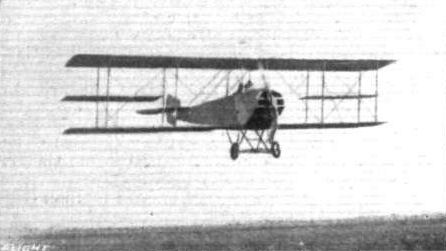Журнал Flight
Flight, July 23, 1915.
THE HUNTINGTON TRACTOR BIPLANE.
THE Huntington tractor biplane, which made its first appearance last March at Hempstead Plains, U.S.A., has been constructed to the designs of H. P. Huntington by Harold Kantner, whose name is no doubt known to our readers in connection with the Kantner-Moisant monoplane. From accounts of trials it appears that the Huntington is a very efficient machine, the speed range, fully loaded, being claimed to be from 45 to 76 miles per hour, although it is fitted with an engine of but 80 h.p. and is by no means a small machine, being 36 ft. span. Both top and bottom planes are of the same span, but the top plane is staggered forward 1 ft 3 ins., and is given an angle of incidence of 4°, whilst that of the lower planes is 2 1/2°. The wing section is very similar to that of the Nieuport, in that the leading and trailing edges are slightly upturned, but in the Huntington there is a little less camber. The planes are built up much in the ordinary way on two main spars, the front one being situated 9 ins. from the leading edge and the rear one 1 ft. 3 ins. from the trailing edge. The spars are of I-section, except at the junctions with the interplane struts, where they are solid and of rectangular section. A neat and simple method of attaching the interplane struts to the spars is employed, whereby the latter are not pierced. Two steel plates, one bent to a U, are clamped to the main spar by two 3/16 in. Bleriot type U bolts, which pass over the plates and around the spar. The U plate receives the end of the strut, on which is a steel ferrule having notches cut in it to clear the U bolt, and the strut is held in position by a bolt passing through it and the U plate. The ends of the second plates are bent up and serve as anchorages for the wire bracing turnbuckles. Between these two plates and the spar is a fibre angle piece which brings the socket and the strut into the correct alignment, and obviates the necessity of cutting the ends of the struts at different angles. The bottom plate is in two parts and is attached to the second and third main body struts, which are of oval section steel tube. The top plane is in three parts, the two outer portions being attached to a small central panel which is supported above the body by four struts. Two pairs of struts on either side of the body separate the top and bottom planes. Hinged to the rear members of these struts, midway between the planes, are the balancing flaps. These are controlled by a single cable which is attached to the top of the flaps only. Rubber cords anchored to the rear spar of the lower plane are attached to the under sides of the flaps, so that when one is pulled up the slack of the cable to the other is taken up by the pull of the rubber cord and this flap is thereby pulled down. In this way a double acting or interconnecting arrangement is obtained. The tail planes are similar to those on the Nieuport, consisting of a semicircular stabilising surface, to the trailing edge of which are hinged two similarly shaped elevators. The rudder, however, differs from that of the Nieuport, being nearly rectangular in shape with a small surface forward of the pivoting axis. All the tail planes are constructed of steel tubing braced together. The body is also similar to that of the Nieuport, being of rectangular section, very deep in the vicinity of the pilot's cockpit. The body is built up of wood, except for the first three struts, which are of oval section steel tubing. The whole of the body is covered with fabric, except for the front portion forward of the cockpit, which is covered with sheet aluminium. The engine, an 80 h.p. 7-cyl. Gyro, is supported by front and rear mountings in the nose of the body, large openings being cut in the front of the aluminium cowl for cooling purposes. Behind the engine is the pilot's seat, immediately behind which is that for the passenger, who sits close up as in the Morane Saulnier. The control is of the usual wheel and rocking column, and rudder-bar type. The undercarriage is a modified Nieuport type consisting of a central tubular steel skid attached to the body by three pairs of V streamlined section steel struts, and a pair of wheels attached to a laminated steel spring mounted in the centre of the central skid. Two auxiliary spiral springs mounted within telescopic tubes, extending from the body to the stud axles, add greatly to the steadiness of the machine when taxying on the ground. The weight of the machine empty is 925 lbs.





